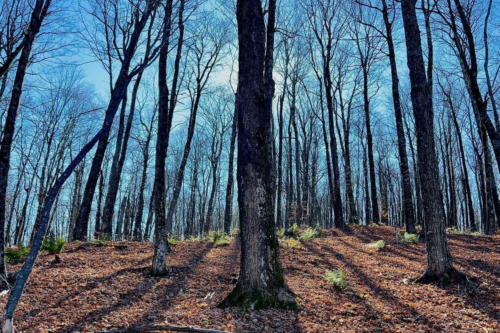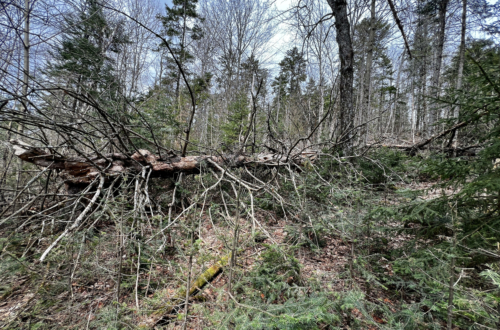Forests are an integral part of the Upper Valley landscape and lifestyle. They host unique and vibrant ecosystems, offer sites for relaxation and recreation, and play a vital role in our local economy. In fact, our own Upper Valley forests are a part of the largest, most intact, and most diverse temperate broadleaf deciduous forest in the world, which stretches across the entire Appalachian Mountain region
But how have our forests changed over time, and what risks do they face now and in the future?
On April 18, Upper Valley residents gathered at the Howe Library in Hanover to learn those answers and more in a talk titled “Why Forests Are Essential,” featuring expert speakers Dr. Joseph Tumber-Dávila, Assistant Professor of Environmental Studies at Dartmouth College; Ethan Tapper, Chittenden County Forester; and Katharine Servidio, Forest Economy Program Manager for Vermont.
The first in a series hosted by local organizations, including the UVLT, on the impacts of declining biodiversity in Vermont and New Hampshire forests, the talk offered a number of key takeaways on the importance of forests and why responsible forestry and conservation are critical to our region’s future.
The Current State of Upper Valley Forests
New England is one of the most heavily forested regions of the United States. Forest covers 80% of New Hampshire and 74% of Vermont, compared to about a third of the nation as a whole.
As Tumber-Dávila explained, pre-colonial New England was dominated by old-growth forests, much of which European colonizers clearcut to farm in the 18th and 19th centuries. In the last hundred years, the departure of many farmers has allowed forest levels to recover. However, our forests are now younger and far less diverse than they were before colonization. Today, the red maple, and to a lesser extent birch, dominate the New England landscape, with little space left for other species. Stressors, including non-native pathogens like beech bark disease, have further decimated the region’s biodiversity.
That’s a problem, said Tapper, because forest health depends on diversity.
“Everybody thinks that a healthy forest looks like perfectly spaced big trees, with nothing growing in the understory — almost like a park,” he explained. “But that’s almost the opposite of a healthy forest. Things that we might see as superfluous or bad or messy are often the most foundational and vital parts of a forest ecosystem.”
Evenly sized trees and little undergrowth indicate a lack of biodiversity.
“Messier” forest areas with a variety of plant species, heavy undergrowth, and decaying organic matter are usually healthier and more biodiverse.
Why Our Forests Matter
Most Upper Valley residents know that our forests are an important economic resource, supporting industries ranging from logging to construction and offering us building materials, a heat source, a medium for fine construction, and much more. In Vermont, Servidio noted, forestry is a bigger part of the economy than agriculture, bringing in more than $2 billion each year and supporting 15,000 jobs. Outdoor recreation, which relies heavily on forests, is another important part of our economy, bringing in more than $7.6 billion each year across New England.
And even when we aren’t out enjoying the forests, they are actively making our lives healthier and more sustainable. New England forests absorb 27 million tons of carbon dioxide each year, 14% of our regional emissions. Additionally, our forests remove 760,000 tons of pollutants from New England air each year, and each acre of forest can filter 530,000 gallons of water annually. That has real knock-on effects — the pollution reduction, for example, is worth an estimated $550 billion in health benefits.
Risks to Upper Valley Forests
Despite their importance, however, our forests face sustained threats from land use, climate change, and the threats of invasive plants, pathogens, and wildlife.
Every year, about 25,000 acres of forest in New England are lost to commercial and residential development — including about 13,000 in New Hampshire alone. This is especially damaging when development breaks up large stretches of forest in a process known as fragmentation, which disrupts essential wildlife corridors and further reduces biodiversity.
Our region also faces serious and compounding risks from climate change. Already, the vernal window — the scientific term for the transition from winter to the growing season — is earlier and longer, and we don’t yet know how this shift will impact forests in the long term. An increasing number of droughts and more frequent, stronger storms are also likely to have serious consequences.
As Tumber-Dávila recently demonstrated, the increasing frequency and severity of hurricanes — already one of the major drivers of ecosystem change in New England forests — will likely cause a significant uptick in tree death and, as a result, release large amounts of stored carbon into the atmosphere. In fact, a single hurricane is likely to wipe out a decade of carbon storage.
What We Can Do
The panelists’ message was clear: the time to protect our forests is now. The first step? Permanently protect as much forest land as possible and avoid further fragmentation of crucial forest ecosystems. Two critical pieces to that work are advocacy for careful zoning and conservation.
Fortunately, as Tumber-Dávila explained, New England forests stand out for another reason beyond their scale. Unlike in most of the Western US, where corporate landowners dominate, 60% of New England’s forest is owned by private families. That gives us a unique conservation opportunity, and it gives those families the chance to help maintain the healthy, intact forests that are critical to all forms of life on Earth.
View a recording of the full event below. Stay tuned for recaps of the other talks in this series!





